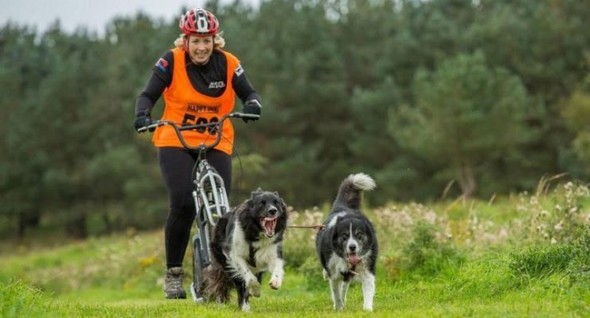———————————————————————————————————————————————————-
We see it all the time, sometimes in hilarious glad-it-isn’t-me videos, other times in our own homes. Energetic dogs who aren’t getting enough exercise utterly trashing the place.
Emily Thomas’ husky-collie mix, Tegan, was precisely one of those dogs. She’d wreck the house while Emily was at work.
Emily found that taking Tegan for a quick morning run solved the problem and she expanded the routing to a couple of runs a week. Sometimes, Tegan would run alongside Emily’s bike. Then, they began to swim. Slowly, the exercise that soothed her savage (if sweet!) beast became a triathlon training regimen!
Tegan, Thomas told Bloomberg, logged 550 miles in her first year according to the Mushometer app they were using.
These days, ultramarathons and highly competitive races are all the rage among the super fit. Before long, the idea of canine triathlons caught on, as well.
The Iron Dog (see the above highlight reel), has been held for the past seven years, organized by an Austrian race dog organization. Similar events have popped up in the Czech Republic, Hungary and Germany. The Tridog competition is coming to the U.K. next year; Tegan and Thomas plan to compete.
To prepare, the two of them (and Thomas’ two other two dogs) are training four to five times a week, strapped to her by marine-grade bungee cord in a lightweight harness–athletic kit that costs anywhere between $87-185. Several sets per dog, she says, are necessary.
“The two boys are water dogs,” Thomas said. “Tegan wasn’t so keen.” Lots of waterborne fetch helped change Tegan’s mind about swimming.

———————————————————————————————————————————————————-
While the organized dog triathlons are relatively new, the concept has its roots in dog sledding, which of course, were held only on snow.
Sled dog racing originally happened only on snow. Later, three-wheeled rigs were created and the discipline of “scooterjor,” or dry-land mushing, was invented. A version of this is used in dog triathlon to replace what would be the cycling leg of a human triathlon.
Naturally, the courses are shorter, as well, so as not to overheat or exhaust competitors.
Training, though, isn’t much different. Thomas’ dogs go running three times a week, and alternate two weekly sessions of bike training in the winter with swimming in the summer.
Aside from the fun, there are other benefits for the dogs. Thomas’s husky mix, a rescue dog, suffered from separation anxiety. Her behavior shifted when Thomas began running with her.
“I’ve got three high-energy dogs and all I need to do is take them out for a half-hour run in the morning, and they’re fine the rest of the day,” she said.
Interestingly, Gudrun Ravetz, president of the British Veterinary Association, is a triathlete herself. Her labrador, Tess, runs with her but probably isn’t suited to triathlon, she told Bloomberg. That said, she’s a supporter of Tridog.
“Anything that encourages people to enjoy their time with their dogs responsibly in the outdoors is good for the health of the dog, both mental and physical,” Ravetz said.
